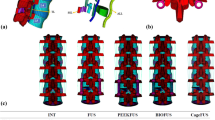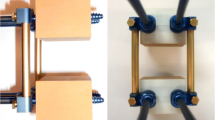Abstract.
Sublaminar wiring with posterior instrumentation is one of the methods used when long fusions involving 10–12 thoracolumbar levels are required. Classically, wires are used at every consecutive level to make the construct as rigid as possible, although complications like dural tears, cerebrospinal fluid leak, and neurological deficit have been reported during their passage. We compared the mechanical stability under torsional strain of five specimens of each of three construct designs, by static and fatigue testing, using an electro-servo-hydraulic testing machine. In construct A, a contoured Hartshill rectangle was used from T2 to L2, with sublaminar wires passed at every level. In construct B, the Hartshill rectangle was wired to the spine at every alternate level. In construct C, every alternate level was wired except at the proximal end, where two consecutive levels were wired. Industrially fabricated spine models were used to prepare these constructs. The intervertebral motion within the construct was measured using the Fastrak magnetic field sensor device. On static testing, no statistically significant difference was found in the rotational displacement of the three construct designs. On fatigue testing, all samples of construct B consistently failed, with breakage of the wire at the most proximal level on the left side. But on adding additional wires to the next level (construct C), all five samples withstood fatigue testing at 300 N load to three million cycles. We conclude that wiring alternate levels instead of every level does not compromise the stability of the construct, provided that the most proximal two levels are consecutively wired. This practice would minimise the risk of dural tears and cord damage during wire passage and reduce surgical time, not to mention the economic benefits.
Similar content being viewed by others
Author information
Authors and Affiliations
Corresponding author
Additional information
Electronic Publication
Rights and permissions
About this article
Cite this article
Gadgil, A., Ahmed, E., Rahmatalla, A. et al. A study of the mechanical stability of scoliosis constructs using variable numbers of sublaminar wires. Eur Spine J 11, 321–326 (2002). https://doi.org/10.1007/s00586-002-0473-z
Received:
Accepted:
Published:
Issue Date:
DOI: https://doi.org/10.1007/s00586-002-0473-z




